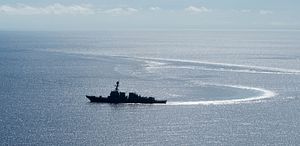Despite its recent tragic incidents, the United States Navy has adopted a cool-headed new approach to Freedom of Navigation Operations (FONOPS) in the South China Sea. Long overdue, it is a clear, firm, enforcement of the international maritime order and reflects a strategic vision that should be applied across the board in America’s China policy.
Pacific Command (PACOM) under Admiral Harry Harris announced this week that, henceforth, PACOM will conduct FONOPS on a regular schedule so that each individual transit will be seen by China and others as a routine happening and not a special, provocative event. The Navy laid the foundation for this sensible new posture with the three operations already conducted this year.
All were authentic FONOPS that challenged the excessive maritime claims of China and/or other nations around disputed land features — which is the stated purpose of the FONOPS program. This contrasts markedly with the four transits the Navy made through China-claimed waters in 2015-16. Those confusing operations were all “innocent passages,” meaning they not only did not challenge China’s sweeping claim of vast territorial seas, but actually conceded it.
Now that the Navy has re-established the international law of the sea as the new normal in the South China Sea, it would be useful to apply the same approach to transits through the Taiwan Strait, an equally clear case for freedom of navigation. The Navy’s Strait passages in the past have been separated by inordinately long intervals that in Beijing’s mind tended to concede China’s claim to that body of water. When transits were resumed sporadically, China would portray them as U.S. provocations.
After World War II, the U.S. Navy did not bother much with the Strait since U.S. policy did not include Taiwan, or South Korea, as important security interests. That misguided policy changed dramatically when North Korea invaded South Korea in June 1950. President Truman rushed the Seventh Fleet back into the Taiwan Strait where it continued operating essentially unchallenged for the next 22 years.
Then in 1972, to prepare for his historic opening to China, President Nixon decided to show his good faith to Mao Zedong by preemptively withdrawing the fleet from the Strait, and it apparently stayed out until the 1995 Taiwan Strait crisis. When China fired missiles toward Taiwan to protest a U.S. visit by Taiwan’s president, President Clinton responded by sending the Nimitz carrier battle group through the Strait. But after Beijing’s angry protest, Washington explained it away as a weather diversion, effectively conceding it needed China’s permission to use the Strait.
When China again fired missiles the following March to oppose Taiwan’s first direct presidential election, Clinton sent two carriers to the region, but after Beijing threatened a “sea of fire” if they entered the Strait, they stayed out. And Navy ships avoided the Strait for the next decade, apparently under the impression that it was official U.S. policy.
When Defense Secretary Donald Rumsfeld learned of the self-imposed Taiwan Strait abstinence in 2005, he directed the Navy to commence regular Strait transits. Pacific Commander Admiral Timothy Keating put an exclamation point on the Navy’s new posture in 2007 when Beijing objected to a transit by the USS Kitty Hawk after it was denied a scheduled Hong Kong port visit.
Keating’s response: “We don’t need China’s permission to go through the Taiwan Strait, it is international waters. We will exercise our free right of passage whenever and wherever we choose, as we have done repeatedly in the past, and will do in the future.”
However, given the Obama administration’s reluctance to challenge China’s illegal claims in the South China Sea, it is unclear whether similar shackles were imposed on the Navy’s operations in the Taiwan Strait. The Trump administration gave Beijing a six-month extension of “strategic patience” to help resolve the North Korean crisis, only to be met with further duplicity and self-serving obstructionism. It should now feel unconstrained to assert America’s interests in the Taiwan Strait and in support of Taiwan’s overall security and democratic identity.
Just as the strategic ambiguity that clouded the Navy’s South China Sea operations has now been cleared away, the same should be done regarding any doubts Beijing may harbor as to the U.S. commitment to defend Taiwan. A telephone call from President Trump to President Tsai Ing-wen would be an appropriate way to convey the message.
Joseph Bosco is a former China country director in the office of the secretary of defense, 2005-2006.

































